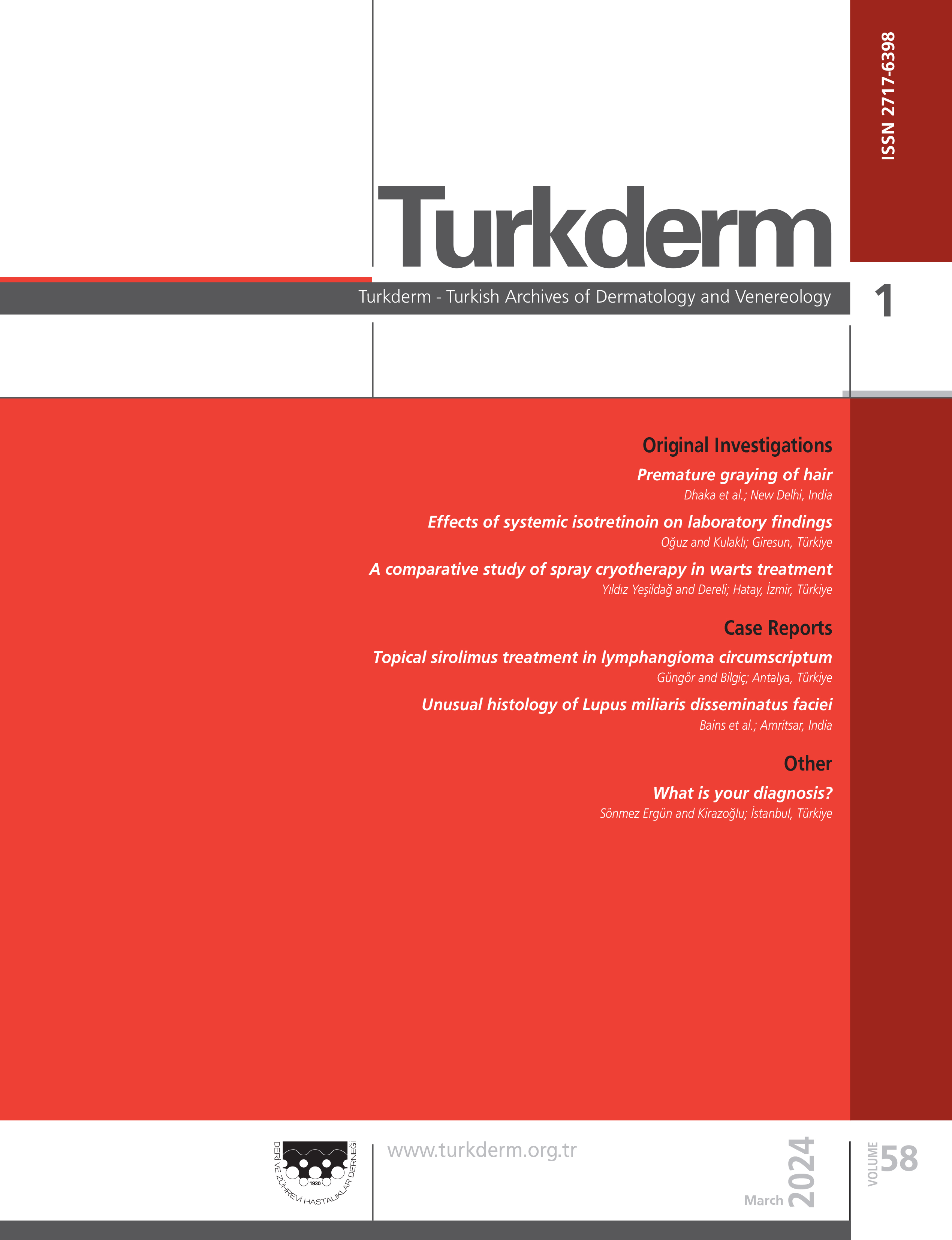Photrichogram Findings in Women Complaining of Hair Loss for Long Duration
Özgür Yürüker, Tuğba Rezan Ekmekçi, Adem KöşlüŞişli Etfal Eğitim Ve Araştırma Hastanesi Dermatoloji Kliniği, İstanbul, TurkeyBackgorund and Design: The phototrichogram (PTG) is a deminvasive test to define hair loss. In this study, PTG findings in 55 women complaining of hair loss for a long time were examined. MATERIALS-METHODS: The patients were divided into three groups according to Ludwig classification and hair pull test. FTG was applied to the patients midscalp and occipital regions by digital camera attached to a dermoscope. Hair density, percentages of thin hair and non-growing hair were estimated. RESULTS: Fourteen of patients were AGA, 10 were hair pull test (+), 31 were hair pull test (-). In AGA group while hair density was statistically lower on the midscalp than occiput, percentages of thin hair and non-growing hair were higher. In hair pull test (+) group, hair density was higher on the midscalp than occiput. In hair pull test (-) group, percentage of non-growing hair was higher. On the midscalp, while hair density was statistically lower in AGA group than the other groups, percentage of thin hair was higher. On the midscalp percentage of non-growing hair was statistically higher in AGA group and hair pull test (+) group than hair pull test (-) group. On the occiput there was statistically difference between hair pull test (+) group and hair pull test (-) group. CONCLUSION: PTG alone isnt enough diagnostic tool. Because standart deviations of three parametres are high, their normal value can not be mentioned. PTG done by comparing two regions can be helpful to diagnose early AGA.
Keywords: Androgenetic alopecia, phototrichogram, telogen effluviumUzun Süreli Saç Dökülme Şikayeti Olan Kadınlarda Fototrikogram Bulguları
Özgür Yürüker, Tuğba Rezan Ekmekçi, Adem KöşlüŞişli Etfal Eğitim Ve Araştırma Hastanesi Deri ve Zührevi Hastalıklar Kliniği, İstanbul, TürkiyeAMAÇ: Fototrikogram (FTG), saç hastalıklarının tanısında kullanılan yarı invaziv bir metoddur. Bu çalışmada, uzun süreli saç dökülme şikayeti olan 55 kadın hastadaki FTG bulguları araştırıldı. GEREÇ-YÖNTEM: Hastalar Ludwig sınıflaması ve saç çekme testine göre üç gruba ayrıldı. Hem midskalp hem oksipital bölgelerine dermoskopa bağlanan dijital kamera yoluyla FTG uygulandı. Saç dansitesi, ince ve uzamayan saç yüzdeleri hesaplandı. BULGULAR: Hastaların 14ü AGA, 10u saç çekme testi(+), 31i saç çekme testi(-) idi. AGA grubunda saç dansitesi midskalpte oksiputa göre anlamlı olarak düşükken, ince ve uzamayan saç yüzdeleri yüksekti. Saç çekme testi(+) grupta saç dansitesi midskalpte oksiputa göre anlamlı olarak yüksekken, saç çekme testi(-) grupta uzamayan saç yüzdesi yüksekti. Midskalpte saç dansitesi AGA grubunda diğer iki gruba göre anlamlı olarak düşükken, ince saç yüzdesi yüksekti. Midskalpte uzamayan saç yüzdesi AGA ve saç çekme testi(+) grupta, saç çekme testi(-) gruba göre anlamlı olarak yüksekken, oksiputta saç çekme testi(+) ve saç çekme testi(-) grup arasında anlamlı fark vardı.
SONUÇ: FTG, tek başına tanı koydurucu değildir. Üç parametrede de standart sapmaların yüksekliği, normal değerden bahsetmeyi imkansız kılar. İki bölge karşılaştırılarak yapılacak FTG, erken dönem AGA da tanı koymaya yardımcı olabilir.
Corresponding Author: Tuğba Rezan Ekmekçi, Türkiye
Manuscript Language: Turkish






















